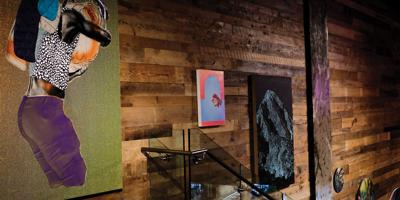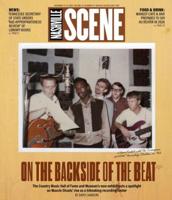
Installation view: A Fluid & Emphatic Now at Bobby
Nashville’s visual art community has been “up-and-coming” for as long as many locals can remember, always at the edge of breaking through and transcending the “Music City” moniker — a nickname that celebrates creativity but fails to acknowledge the nuances of our city’s vibrant visual art scene. But the reasons why Nashville was a great town for artists 10 years ago — the affordability of studio space, the low cost of living — are no longer its selling points. At the same time, galleries and art schools are closing, museums are changing leadership, and new modes of exhibiting artwork abound. It’s a good time, then, to assess what’s working in Nashville’s art scene, as well as what might need to change.
In recent months, some of Nashville’s most popular galleries have announced closures. Rymer Gallery, one of the first spaces to participate in the First Saturday art crawls, quietly shuttered when owner Jeff Rymer retired, with the downtown building housing the gallery selling at the end of 2021. One of the most consistent spots for high-quality art in Wedgewood-Houston, Channel to Channel, left its Packing Plant home to relocate to Chattanooga. The downtown Arcade, which was ground zero for the First Saturday art crawls when the tradition began 16 years ago, has recently sold to local real estate industry veteran Rob Lowe and New York City-based Linfield Capital, which paid $28 million for the building in April 2021.
The art scene isn’t all bad news, however. Though Nashville still has many high-caliber examples of traditional galleries, a slew of new options seem to offer innovative business models. Among the most inventive developments in Nashville’s art scene are the partnerships between artists and downtown hotels with the budget to fill their walls, and creative values that honor local visionaries. In 2017, downtown hotel Noelle enlisted artist Bryce McCloud to be its director of programming and creative projects. He commissioned a series of portraits of noteworthy Nashvillians — including two portraits of the Scene’s late editor Jim Ridley — from local artists like Julia Martin and LeXander Bryant. McCloud’s own work is in the expansive lobby and hotel restaurant MakeReady.
Just up Fourth Avenue North from Noelle is Bobby, another downtown boutique hotel with a visual-art connection: The hotel partners with Fifth Avenue gallery Tinney Contemporary to host The Collection at Bobby, a revolving series of exhibitions in its lobby. Tinney’s gallery manager and curator Joshua Edward Bennett seems to have an ideal vision for the balance between work that is visually striking and conceptually interesting. The current Tinney exhibit at Bobby, A Fluid & Emphatic Now, includes lo-fi neon works from Brooklyn-based artist Esther Ruiz alongside futuristic Memphis-inspired wall sculptures by Miami-based artist Francesco Lo Castro — the vibe is elegant with an edge. Photographs by New Orleans-based artist D-Tag document paper money that’s been folded into shapes that spell phrases like “Cash Rules Everything Around Me” — a trick the artist taught himself while being stuck on the rooftop of his house during Hurricane Katrina. The international scope of the artists at Bobby doesn’t detract from local talent — putting Nashville-based artists alongside artists from outside the city shows confidence in locals by establishing a level playing field.
Another recent innovation in Nashville’s art scene is restaurateurs championing visual art. Acclaimed chef Sean Brock’s latest high-end restaurant, Audrey, features a collection of paintings from legendary outsider artist Mose Tolliver that wouldn’t be out of place in the American Folk Art Museum. Meanwhile, Slim & Husky’s Pizza Beeria opened NKA Gallery, a sleek exhibition space that was consistently mentioned in our visual artists’ poll as a highlight of the city’s recent gallery events — Lakesha Moore, Omari Booker and Shabazz Larkin are among the Nashville-based artists whose work has been shown at NKA.
These developments are no doubt positive — letting local artists shape a city’s visual culture is almost never a bad idea — and will provide additional revenue streams for the artists themselves. Even so, placing local work in high-end restaurants and boutique hotels will reward art that is more easily digestible. That puts the onus for exhibiting risky, challenging art on the institutions that don’t rely on broad public approval or commercial sales to drive business.
For that reason, all eyes seem to be on the Frist Art Museum, whose longtime executive director Susan Edwards announced her impending retirement last year. Edwards has been with the museum since 2004, and under her leadership the Frist has become a hub for exhibitions from greats like Pablo Picasso, Kara Walker and Carrie Mae Weems. The Frist during Edwards’ tenure has also championed local talent like Vesna Pavlović and Vadis Turner — as well as LeXander Bryant, whose upcoming exhibition Forget Me Nots is one of the most anticipated of the season. Her successor may indeed take the museum down a different path — but perhaps a new director could shift the institution toward challenging programming and confrontational exhibitions that Nashville has been missing.
Among the most frequent complaints mentioned in our artists’ poll: the need for artists to be able to take risks, free from commercial or ideological restraint. As stalwarts of Nashville’s art scene — namely the Frist and the downtown Arcade — change hands and evolve into something new, it’s a good time for Nashville’s artists to ask for what they need from a city that has benefited from their contributions.
We poll local artists on the visual arts scene, look at some of the best events of the season and more






